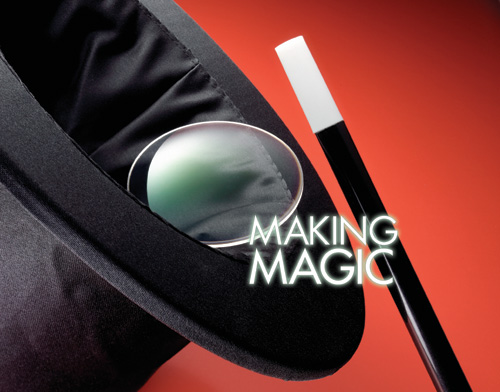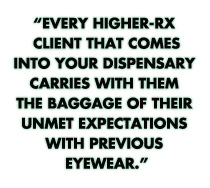
By Barry Santini
Be honest. Have you or your staff, ever twitched, even just a little bit, when gazing upon a new Rx with sphere powers over plus or minus 6.00 diopters? As prescriptions rise into the higher power ranges, has experience taught you to “abandon hope” of meeting, let alone exceeding, your client’s expectations for beautiful, thin eyewear? Can a new pair of eyewear for an -8.00 diopter female myope ever compete as an attractive alternative to contact lenses or (dare I say it) refractive surgery?
With today’s advanced lens, tint and coating technologies, the answer is a resounding YES. Although some “sleight-of-hand” may be necessary when choosing rimless for an Rx of 9.00D, it’s possible for dispensers and labs that come equipped with the proper “toolbox,” but you have to be willing to learn a little magic.
Unsurpassed Expectations
In my experience, no person is a more powerful critic of the selection and delivery of higher-power eyewear than a -7.00D or above myopic client. Compared to hyperopes, myopes can actually see their finished eyewear up close. Jewelers, with their powerful 10x loupes, enjoy little advantage over a -10.00D myope when it comes to inspecting their new “facial jewelry.” And you can bet that every higher-Rx client that comes into your dispensary carries with them the baggage of their unmet expectations with previous eyewear.
Dispensers approaching these strong Rxs start with high-expectations, previous disappointments, experience with poor-quality workmanship, unsatisfactory warranties and, last but not least, a client who harbors the feeling that their frame choice is restricted to what the dispenser suggests. So how can dispensers ever deliver eyewear “even better than you can imagine?” By encouraging your clients to shop for frame fashions first, you can then apply all of today’s magical technologies to make that dream come true.
Can High Rx Eyewear Ever Be Fashionable?
Until the mid-1980s, the only lenses a dispenser had to choose from were plastic and crown glass, both of which have a lower index of refraction. This meant most higher-prescription eyewear was not only thick, it was heavy as well. In the 1950s, for example, higher Rxs were often mounted in rounder, thicker acetate plastic frames, which could hide thick lens edges and were durable.
Freed from style constraints by advances in lens and frame technology, today’s high- plus and minus clients can enjoy many of the same frame fashions as patients with lower Rxs. The “magic” in dispensing higher-Rx eyewear begins, therefore, by helping clients go shopping for eyewear, just as they would for any other fashion accessory. Every major fashion brand has a large selection of plastic, metal and rimless frames (yes, even rimless today for higher-Rxs) in all eye sizes. Begin their shopping experience by discovering what fashion, lifestyle, image or even personality they want their new eyewear to convey. Start by mentally sorting frame styles into the basic construction groups: plastic, metal or rimless.
Antastic Plastic
If your client is attracted to any of the latest plastic styling, the odds of camouflaging their lens thickness has just risen significantly. With a plastic frame’s wider profile, it is much easier to hide any lens extension. If the temple is one of today’s wider profile styles, these will almost completely hide any exposed thickness.
Although manufacturers have long ago eliminated multiple bridge-size offerings, most of today’s styles employ easily-to-remold materials, allowing the dispenser to optimize the nasal fit. Keep in mind the natural alignment, or splay, of a frame’s temples can often be altered by the flatter curves of higher-index, aspheric lenses. This will significantly impact the frame’s comfort and fit through a reduction in head tension.
When purchasing plastic styles, frame buyers should be encouraged to include colors that naturally complement the basic eye colors of brown, green and blue. Be aware, however, that showing a thick, dark, plastic frame to a 50+ year old client will often find them recoiling at the prospect of donning a style they’ve tried to avoid almost all their lives. To soften the blow, suggesting a complement to their eye color will help gain acceptance for these bolder plastic frame styles from Boomers.
Testing Their Metal
Even though plastic frames have become the latest styles on the eyewear fashion scene, metal and semi-rimless styling has not remained stagnant. These frame designs have also been influenced by the trend toward bolder accents and the styles now include wider and more contrasting plastic temples. Wider temples often deliver the same edge-thickness concealing effect of an all-plastic style, while maintaining a lighter and less dominating frontal appearance. With flat-metals, frame designers have expanded the gauge and profile of metal used on eyewire styles in order to craft models that deliver the fashion impact of thicker, all-plastic styling, but with less boldness and facial contrast. This design approach is well-received by clients who currently wear thinner metal or rimless styles. And even all-metal models now feature temples with larger areas of “real-estate” that designers can use to communicate their brand’s lifestyle message.
Rimless is Forever
Dispensers have traditionally steered higher-Rx clients away from rimless frame design. But with no eyewires to define borders for either size or shape, rimless frames offer the freedom to enjoy the luxury of completely custom, “bespoke” eyewear. The ability to specify size, shape and point-of-attachment for bridges and temples allows dispensers to offer an almost limitless array of options in rimless design.

Samples Make Great Examples
Having a collection of samples of finished eyewear in different frames (plastic, metal, semi-rimless and rimless) and different Rxs (plus and minus 4, 6, 8 and 10, etc.), is a terrific way to show your clients how their new high-Rx eyewear will look. I prefer finished pairs, compared to traditional lens “cutaways,” which tend to focus on the lens alone. Taking the lens out of its natural context within the frame focuses a client’s attention on thickness, rather than the bigger picture of how the eyewear actually appears on their face.
A complete pair of finished eyewear will best communicate how it will appear on your client. For these samples, always choose from your best selling and attractive frames, and include samples from each construction style, and keep them updated regularly. Some of the models should be “A-B” styles. A-B styles feature a lens in one side that is thin, but lacks any AR, tint (photochromic or solid) or lens-edge treatment. Nothing makes these enhancements more desirable than to see them alongside a companion lens that lacks them.
In some cases, you may not have to create a sample from scratch. I’m sure all of us have experienced clients that don’t like the styling of their new eyewear. Instead of recycling or disposing of these returns in conventional ways, why not try converting them to an Rx demonstration sample by substituting one lens without all the treatments. Your clients will really appreciate this Rx “show and tell.”
The AR Difference
Anti-reflection coatings are a must for higher prescriptions. High-index materials have greater amplitudes of reflection at each lens surface. And flatter curves permitted by higher material index can combine with the flatter curves of aspheric lens designs to produce at least one surface, front or rear, that has a broad and bright reflection. State-of-the-art, multi-layer AR coatings reduce this reflective tell-tale of Rx strength to negligible levels. For higher hyperopic corrections, it is desirable to specify coatings with a gold residual reflection in order to help mask the magnifying effect of plus lenses.
Frame Size and Shape
For very-high Rxs, it is desirable to influence frame selection toward smaller eyesizes. Although plus prescriptions become thinner as eyesize is reduced, you should consider the magnified “eye” effect can be compounded by the use of smaller frames, particularly those made of plastic. In addition, this “large-eye” effect favors frames with taller B dimensions. Taller shapes, such as ovals and rounds, will tend to thin out the residual thickness that’s often exposed at the top or bottom of high-plus Rxs.
Edge-Color Treatments: The Finishing Touch
Besides AR coatings, nothing will improve appearance and reduce unsightly “coke-bottle” rings more than an edge-color treatment. While many higher-index lens materials, particularly polycarbonate, often look better when polished, shiny lens edges can exacerbate the ring-effect with even modest strength prescriptions. Even in a thicker frame that hides most of the lens extension, these shiny, edge-ring effects often belie Rx strength to a lay observer. For moderate thickness lenses, the new translucent color pens are easy-to-use and do an excellent job offsetting this shiny-ring effect. For thicker edges, use a matte edge and try a lab-applied, baked-epoxy finish. These advanced treatments not only decrease edge shine more than edge-pens, they are also more durable and long lasting.
The Sorcerer’s Apprentice – Teaching Your Staff the Magic
Combining today’s fashion and lens technology with a sales approach that projects confidence and expertise is the key to overcoming the baggage of previous disappointments. Keeping a variety of Rx samples finished in the latest eyewear fashions can make shopping for new eyewear exciting for your higher-Rx clients. Regular meetings, wherein you teach and re-enforce your staff how their hard skills of dispensing should be melded with the soft skills of salesmanship are essential.
Through the teaching of some simple magic, you can show staff how to finally unleash freedom of choice for your higher-Rx clients. This will allow these clients to experience, possibly for the first time, the joy of wearing fashionable eyewear. As satisfied shoppers, they will naturally seek to expand and cultivate their own eyewear wardrobe. And that’s a scenario guaranteed to improve your bottom line.
Barry Santini is a New York State licensed optician based in Seaford, N.Y.











